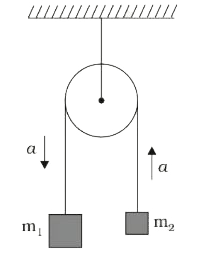A partical of mass M at rest decays into two Particles of masses
m1andm2 having non-zero velocities. The ratio of the de - Broglie wavelengths
of the particles λ1∣λ2 is
(a) m1/m2 (b)m2/m1 (c ) 1 (d)√,2/√_1
The correct Answer is:A, C
To solve the problem, we need to find the ratio of the de Broglie wavelengths of two particles resulting from the decay of a particle at rest. Let's go through the solution step by step.
Step 1: Understand the conservation of momentum
A particle of mass M is at rest and decays into two particles of masses m1 and m2 with velocities v1 and v2. According to the law of conservation of momentum:
Initial momentum=Final momentum
Since the initial momentum is zero (the particle is at rest), we have:
0=m1v1+m2v2
This implies:
m1v1=−m2v2
Step 2: Express the relationship between velocities
Taking the magnitudes, we can write:
m1v1=m2v2
From this, we can express the ratio of the velocities:
v1v2=m2m1
Step 3: Use the de Broglie wavelength formula
The de Broglie wavelength λ of a particle is given by:
λ=hmv
where h is Planck's constant, m is the mass of the particle, and v is its velocity.
Step 4: Write the expressions for the de Broglie wavelengths
For the two particles, we have:
λ1=hm1v1andλ2=hm2v2
Step 5: Find the ratio of the de Broglie wavelengths
Now, we can find the ratio λ1λ2:
λ1λ2=hm1v1hm2v2=m2v2m1v1
Substituting the relationship we found earlier:
λ1λ2=m2v2m1(m2m1v2)=m2m1
Step 6: Conclusion
Thus, the ratio of the de Broglie wavelengths of the two particles is:
λ1λ2=m2m1
Therefore, the correct answer is option (b) m2m1.
A particle of mass M is at rest and decays into two particles of masses m1 and m2 with velocities v1 and v2. According to the law of conservation of momentum:
Initial momentum=Final momentum
Since the initial momentum is zero (the particle is at rest), we have:
0=m1v1+m2v2
This implies:
m1v1=−m2v2
Taking the magnitudes, we can write:
m1v1=m2v2
From this, we can express the ratio of the velocities:
v1v2=m2m1
The de Broglie wavelength λ of a particle is given by:
λ=hmv
where h is Planck's constant, m is the mass of the particle, and v is its velocity.
For the two particles, we have:
λ1=hm1v1andλ2=hm2v2
Now, we can find the ratio λ1λ2:
λ1λ2=hm1v1hm2v2=m2v2m1v1
Substituting the relationship we found earlier:
λ1λ2=m2v2m1(m2m1v2)=m2m1
Thus, the ratio of the de Broglie wavelengths of the two particles is:
λ1λ2=m2m1
Therefore, the correct answer is option (b) m2m1.
Topper's Solved these Questions
- MODERN PHYSICS - 1BOOK - DC PANDEY ENGLISHCHAPTER - MODERN PHYSICS - 1EXERCISE - Example Type 1
2 Videos
- MODERN PHYSICS - 1BOOK - DC PANDEY ENGLISHCHAPTER - MODERN PHYSICS - 1EXERCISE - Example Type 2
6 Videos
- MODERN PHYSICSBOOK - DC PANDEY ENGLISHCHAPTER - MODERN PHYSICSEXERCISE - Integer Type Questions
17 Videos
- MODERN PHYSICS - 2BOOK - DC PANDEY ENGLISHCHAPTER - MODERN PHYSICS - 2EXERCISE - Level 2 Subjective
10 Videos
Similar Questions
A praticle of mass M at rest decays into two particle of masses m1 and m2, having non-zero velocities. The ratio of the de Broglie wavelength of the particles λ1λ2 is
View SolutionA particle of mass 3m at rest decays into two particles of masses m and 2m having non-zero velocities. The ratio of the de Broglie wavelengths of the particles (λ1λ2) is
View Solution
Knowledge Check
A particle of mass 4m at rest decays into two particles of masses m and 3m having non-zero velocities. The ratio of the de Broglie wavelengths of the particles 1 and 2 is
A12B14C2D1The reduce mass of two particles having masses m and 2 m is
A2 mB3 mC2 m/3Dm/2Two particles A1andA2 of masses m1,m2(m1>m2) have the same de-broglie wavelength. Then
Atheir momenta are the same.Btheir energies are the same.Cmomentum of A1 is less than the momentum of A2.Denergy of A1 is more than the energy of A2.
Two bodies of masses m1andm2(<m1) are connected to the ends of a massless cord and allowed to move as shown in figure. The pulley is both massless and frictionless. The acceleration of the centre of mass is (m1−m2)n(m1+m2)2g. Find the value of n.

View SolutionAssertion: A particle of mass M at rest decays into two particles of masses m1 and m2, having non-zero velocities will have ratio of the de-broglie wavelength unity.
Reason: Here we cannot apply conservation of linear momentum.
View SolutionTwo particles of masses m and 2m have equal kinetic energies. Their de Broglie wavelengths area in the ratio of:
View SolutionThe de-Broglie wavelength of a particle with mass 1g and velocity 100m/sec is.
View SolutionTwo particles A1andA2 of masses m1,m2(m1>m2) have the same de-broglie wavelength. Then
View Solution
